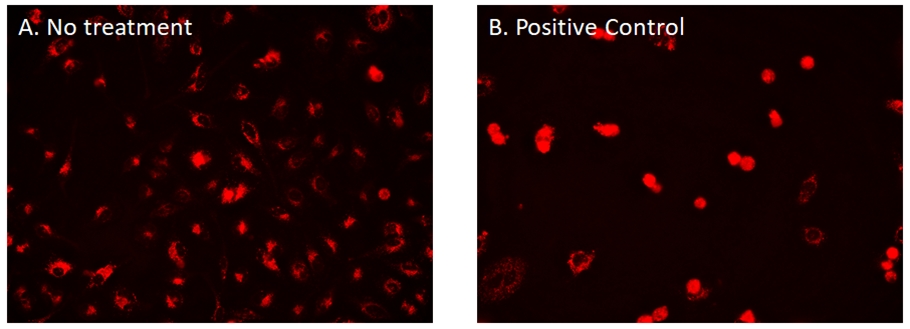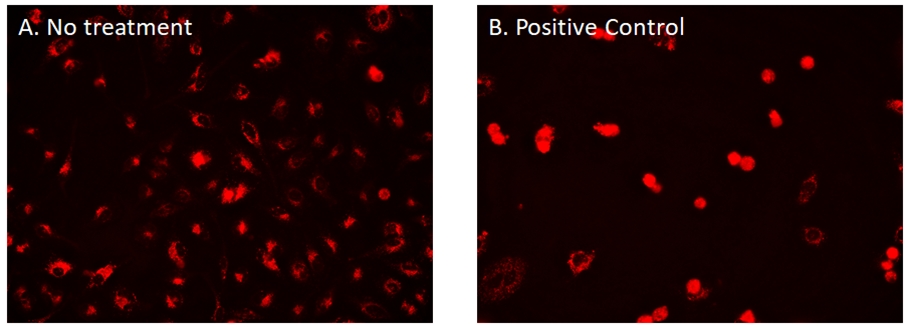上海金畔生物科技有限公司代理AAT Bioquest荧光染料全线产品,欢迎访问AAT Bioquest荧光染料官网了解更多信息。
Cell Navigator CDy6有丝分裂成像试剂盒
 |
货号 | 22640 | 存储条件 | 在零下15度以下保存, 避免光照 |
| 规格 | 100 Tests | 价格 | 3732 | |
| Ex (nm) | Em (nm) | |||
| 分子量 | 溶剂 | |||
| 产品详细介绍 | ||||
简要概述
有丝分裂是细胞生长的最决定性阶段。 Cell Navigator CDy6有丝分裂成像试剂盒是通过观察溶酶体动力学来检测有丝分裂的使用工具。CDy6有丝分裂成像试剂盒使用可渗透细胞的溶酶体染料CDy6,该染料在酸性环境中表现出高灵敏度,并在溶酶体中表现出明亮的信号。在有丝分裂期间,溶酶体迅速向核堆积,信号强度的急剧增加,可以实时查看。
适用仪器
| 荧光显微镜 | |
| 激发: | Cy3/TRITC滤波片组 |
| 发射: | Cy3/TRITC滤波片组 |
| 推荐孔板: | 黑色透明 |
产品说明书
样品实验方案
简要概述
在96孔板中制备细胞(100 µL /孔)
添加10X CDy6工作溶液(10 µL /孔)
添加待测化合物
在37°C下孵育
使用Cy3 / TRITC滤波片组的荧光显微镜成像
溶液配制
1.储备溶液配制
CDy6储备溶液配制
将15 µL DMSO加入小瓶CDy6(组分A)中,制成1000X CDy6储备液,注意避光。
诺考达唑溶液配制
将50 µL DMSO加入含诺考达唑的小瓶(组分B)中,制成1000X 诺考达唑储备液。
2.工作溶液配制
CDy6工作溶液配制
在您选择的100 µL培养基或缓冲液中加入1 µL 1000X CDy6溶液,并充分混合。
注意,100 µL的10X CDy6工作溶液足以以96孔板的形式进行10次测试。在实验之前准备足够的10X CDy6工作溶液,并立即使用。
可选:诺考达唑工作溶液(10X)
通过将1 µL 诺考达唑与100 µL培养基混合,制备10X 诺考达唑工作溶液以进行阳性对照。
样品示例及操作
1.在透明底孔板中,添加1000到40,000个细胞/孔(对于96孔板为90 µL,对于384孔板为22.5 µL)。
2.向每个孔中添加10 µL /孔(96孔板)或2.5 µL /孔(384孔板)的10X CDy6工作溶液。
3.将待测化合物添加到细胞中,并在5%CO2培养箱中于37°C孵育(例如24、48或96小时)。
4.(可选)对于阳性对照,向每个孔中添加11X /孔(96孔板)或3 µL /孔(384孔板)的10X 诺考达唑工作溶液,并在37°C的5%CO2培养箱中孵育16小时℃。治疗后有丝分裂细胞群将呈现富集状态。
注意,应对每个细胞系进行单独评估,以确定最佳细胞密度。
5.使用Cy3 / TRITC滤光片组的荧光显微镜成像。
图示

图1.用Cell Navigator CDy6有丝分裂成像试剂盒染色的HeLa细胞图像。 A.未经处理的对照细胞。 B.用阳性对照(诺考达唑)处理的细胞富集有丝分裂细胞群。
参考文献
Cyclodextrin-Based Peptide Self-Assemblies (Spds) That Enhance Peptide-Based Fluorescence Imaging and Antimicrobial Efficacy.
Authors: Jiao, Jin-Biao and Wang, Guan-Zhen and Hu, Xi-Le and Zang, Yi and Maisonneuve, Stéphane and Sedgwick, Adam C and Sessler, Jonathan L and Xie, Juan and Li, Jia and He, Xiao-Peng and Tian, He
Journal: Journal of the American Chemical Society (2020): 1925-1932
In Vitro FRET- and Fluorescence-Based Assays to Study Protein Conformation and Protein-Protein Interactions in Mitosis.
Authors: Ems-McClung, Stephanie C and Walczak, Claire E
Journal: Methods in molecular biology (Clifton, N.J.) (2020): 93-122
[An acute myeloid leukemia case with concurrent 11q23 anomaly and D13S319 deficiency diagnosed by combined inter- and metaphase fluorescence in situ hybridization].
Authors: Zhang, Zhenhao and Wang, Yanfang and Wan, Wei and Ke, Xiaoyan
Journal: Zhonghua yi xue yi chuan xue za zhi = Zhonghua yixue yichuanxue zazhi = Chinese journal of medical genetics (2020): 48-51
Enantioselective and Differential Fluorescence Lifetime Imaging of Nucleus and Nucleolus by the Two Enantiomers of Chiral Os(II) Polypyridyl Complex.
Authors: Huang, Rong and Huang, Chun-Hua and Shao, Jie and Zhu, Ben-Zhan
Journal: The journal of physical chemistry letters (2019): 5909-5916
Examination of Mitotic and Meiotic Fission Yeast Nuclear Dynamics by Fluorescence Live-cell Microscopy.
Authors: Escorcia, Wilber and Shen, Kuo-Fang and Yuan, Ji-Ping and Forsburg, Susan L
Journal: Journal of visualized experiments : JoVE (2019)
Is in vivo and ex vivo irradiation equally reliable for individual Radiosensitivity testing by three colour fluorescence in situ hybridization?
Authors: Mayo, Theresa and Haderlein, Marlen and Schuster, Barbara and Wiesmüller, Anna and Hummel, Christian and Bachl, Maximilian and Schmidt, Manfred and Fietkau, Rainer and Distel, Luitpold
Journal: Radiation oncology (London, England) (2019): 2
Liposomal OTS964, a TOPK inhibitor: a simple method to estimate OTS964 association with liposomes that relies on enhanced OTS964 fluorescence when bound to albumin.
Authors: Gilabert-Oriol, Roger and Sutherland, Brent W and Anantha, Malathi and Pallaoro, Alessia and Bally, Marcel B
Journal: Drug delivery and translational research (2019): 1082-1094
An optimized method for 3D fluorescence co-localization applied to human kinetochore protein architecture.
Authors: Suzuki, Aussie and Long, Sarah K and Salmon, Edward D
Journal: eLife (2018)
Discrepant Cytogenetic and Interphase Fluorescence In Situ Hybridization (I-FISH) Results from Bone Marrow Specimens of Patients with Hematologic Neoplasms.
Authors: Cantú, Eduardo S and Dong, Henry and Forsyth, David R and Espinoza, Froilan P and Papenhausen, Peter R
Journal: Annals of clinical and laboratory science (2018): 264-272
Fluorescence In Situ Hybridization (FISH) in Multiple Myeloma.
Authors: Tian, Erming
Journal: Methods in molecular biology (Clifton, N.J.) (2018): 55-69
